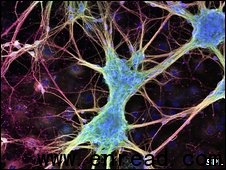| ||||||||||||||||||||||||||||||||||||||||||||||||||||||||||||||||||||||||
|
a 1, 2 artificial human brain can be built within the next 10 years, a leading scientist has claimed. 一位领导性的科学家宣称,一个详细的、机能完整的人工大脑将在未来的十年内被制造出来。  the team are trying to reverse engineer the brain henry markram, director of the blue brain project, has already simulated(伪装的,模仿的) elements of a rat brain. he told the 3 global conference in 4 that a 5(合成的,人造的) human brain would be of particular use finding treatments for mental illnesses. around two billion people are thought to suffer some kind of brain impairment(损伤), he said. "it is not impossible to build a human brain and we can do it in 10 years," he said. "and if we do succeed, we will send a hologram(全息照相) to ted to talk." 'shared 6' the blue brain project was launched in 2005 and aims to reverse engineer the mammalian(哺乳动物的) brain from laboratory data. in particular, his team has focused on the neocortical(新皮层) column - repetitive units of the mammalian brain known as the neocortex. "it's a new brain," he explained. "the mammals needed it because they had to cope with parenthood(父母的身份), social interactions complex 7 functions. "it was so successful an evolution from mouse to man it expanded about a thousand fold in terms of the numbers of units to produce this almost frightening organ." and that evolution continues, he said. "it is evolving at an enormous speed." over the last 15 years, professor markram and his team have picked apart the structure of the neocortical column. "it's a bit like going and cataloguing a bit of the rainforest - how may trees does it have, what shape are the trees, how many of each type of tree do we have, what is the position of the trees," he said. "but it is a bit more than cataloguing because you have to describe and discover all the rules of communication, the rules of connectivity." the project now has a software model of "tens of thousands" of neurons(神经原,神经细胞) - each one of which is different - which has allowed them to digitally construct an artificial neocortical column. although each neuron is unique, the team has found the patterns of circuitry in different brains have common patterns. "even though your brain may be smaller, bigger, may have different morphologies(形态学,语形论) of neurons - we do actually share the same fabric," he said. "and we think this is species specific, which could explain why we can't communicate across species." world view to make the model come alive, the team feeds the models and a few algorithms into a supercomputer. "you need one laptop to do all the calculations for one neuron," he said. "so you need ten thousand laptops." instead, he uses an ibm blue 8 machine with 10,000 processors. simulations have started to give the researchers clues about how the brain works. for example, they can show the brain a picture - say, of a flower - and follow the electrical activity in the machine. "you excite the system and it actually creates its own representation," he said. ultimately, the aim would be to extract that representation and project it so that researchers could see directly how a brain perceives(觉察,感觉) the world. but as well as advancing neuroscience and philosophy, the blue brain project has other practical applications. for example, by pooling all the world's neuroscience data on animals - to create a "noah's ark", researchers may be able to build animal models. "we cannot keep on doing animal experiments forever," said professor markram. it may also give researchers new insights into diseases of the brain. "there are two billion people on the planet 9 by mental disorder," he told the audience. the project may give insights into new treatments, he said. the ted global conference runs from 21 to 24 july in oxford, uk. 点击  收听单词发音 收听单词发音
|
||||||||||||||||||||||||||||||||||||||||||||||||||||||||||||||||||||||||
- 发表评论
-
- 最新评论

